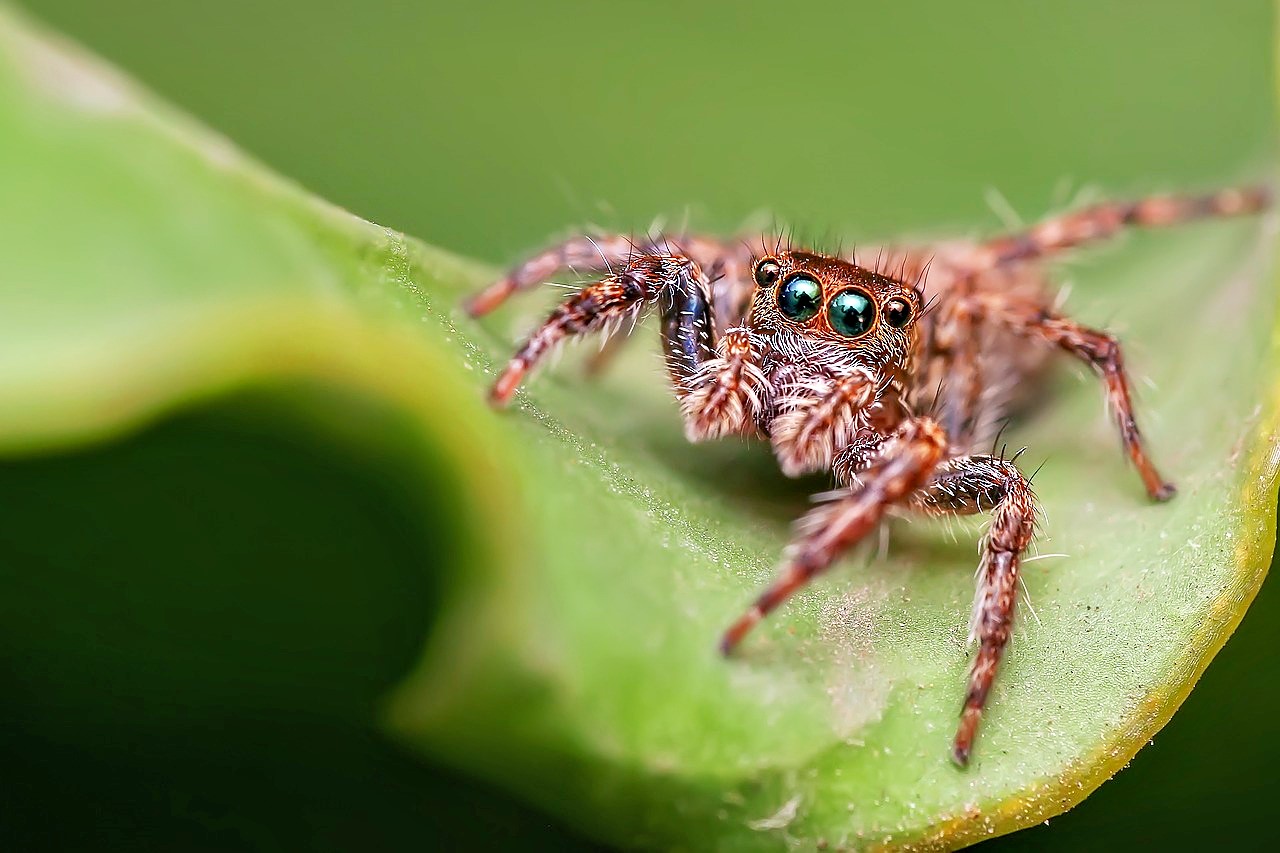Meet the Jumping Spiders 🕷️🥰
Once upon a time, a video featuring a peculiar spider went viral, garnering over 10 million views! 🎥🔥 With its square-shaped head, beady eyes, and a droplet perched atop, this adorable arachnid captivated hearts worldwide. Known as the Hytrillium or “fly-eating spider” in Japanese, these creatures are more commonly referred to as “jumping spiders” or “zebra spiders.” 🔍🕷️
A Diverse Family 👪🌎
Jumping spiders belong to the Salticidae family, boasting over 6,000 species – nearly as many as the entire class of mammals! 🐭🐘 They’re the largest spider family, accounting for roughly 13% of all spider species. Found on every continent except Antarctica, these charismatic critters come in various shapes and sizes, ranging from just 1 mm to an impressive 25 mm in length. 📏🕷️
Appearance Fit for a Robot 🤖
With their boxy heads and four perfectly aligned eyes (two large and two small), jumping spiders resemble tiny robots or futuristic cars. 🚗🕷️ Some species even flaunt vibrant colors and lion-like manes, earning them the moniker “lion cubs of the spider world.” This striking sexual dimorphism allows males to attract potential mates through dazzling displays. 💃🕺
Hunting Like a Mighty Tiger 🐅
Unlike web-weaving spiders that passively await their prey, jumping spiders actively hunt like miniature tigers. 🐯 Locking onto their target with exceptional eyesight, they stealthily approach before pouncing with explosive force, subduing their victims with venom. Their leaping abilities are awe-inspiring, with some species jumping up to 50 times their body length – the equivalent of a human leaping 89 meters! 🤯💥
A Marvel of Engineering 🔬
The jumping spider’s leaping prowess is a marvel of engineering. Unlike insects that rely on powerful leg muscles, these arachnids employ a hydraulic system. By compressing bodily fluids and releasing the pressure into their legs, they can straighten them instantaneously, propelling themselves through the air with incredible speed. 🚀 Additionally, they use silk strands to stabilize their aerial maneuvers, ensuring precise landings. 🕸️🎯
Visionary Hunters 👁️🔍
Jumping spiders boast one of the most sophisticated visual systems in the animal kingdom. With a principal pair of telescope-like eyes providing sharp, focused images and several secondary eyes offering a 360-degree panoramic view, they can locate, track, and judge the distance to their prey with remarkable accuracy. Some species even possess tri- or quad-chromatic vision, painting the world in vivid hues. 🌈🕷️
To achieve this visual prowess, jumping spiders employ an ingenious technique called “image defocusing.” Their principal eyes possess two layers of retinas – one in focus and another slightly out of focus. By analyzing the degree of blurriness in the defocused image, they can accurately gauge the distance to their prey, akin to the bokeh effect in photography. 📷🔭
Moreover, these astounding arachnids can distinguish between different wavelengths of light, enabling them to perceive a wider range of colors than humans. While their primary retinas are sensitive to green light, some species possess additional retinal layers that allow them to perceive ultraviolet, blue, and even red wavelengths. 🌈👁️
The Courtship Extravaganza 💃🕺
When it comes to courtship, male jumping spiders truly steal the show! 🎭 Species like the peacock spider perform elaborate dances, raising their vibrantly colored abdomens like a peacock’s tail to entice potential mates. 🦚 Others produce sounds through vibrations, creating a percussive backdrop for their mesmerizing choreography. However, the ritual can be perilous, as females may attack and consume unimpressive suitors. 😨🕷️
The remarkable diversity in courtship displays among jumping spiders is a testament to their evolutionary adaptations. Some species, like the Australian peacock spider, have evolved intricate mating rituals that involve raising their colorful abdomens, waving their legs, and performing intricate dance moves. 💃🕺 The vibrant hues and patterns on their bodies serve as visual signals to attract potential mates and establish dominance over rivals.
In other species, such as the Habronattus courtship spider, males produce specific vibrational patterns by drumming their bodies against the substrate. These percussive signals, combined with visual cues like leg-waving and abdomen-raising, create a multi-sensory spectacle designed to captivate potential partners. 🎵🕺
However, the courtship process can be treacherous for male jumping spiders. Females, often larger and more formidable, may cannibalize unsuitable or unskilled suitors. This harsh selectivity ensures that only the fittest and most impressive males pass on their genes to the next generation, driving the evolution of increasingly elaborate and theatrical mating displays. 💀🕷️
Copyright © 2025 Hea1th.net

